On Figure Painting > > > Contemporary figurative artist Alan Feltus shares a thoughtful essay on painting the nude female figure.
By Alan Feltus (www.alanfeltus.com)
Throughout the history of painting there have always been nude figures interacting with each other, and with clothed figures. While nudity is common and perfectly acceptable in art, of course conventions vary in different cultures about what is considered proper and what is thought to be improper; and what meanings might be implied by nudity also changes with context. Nude female figures in Renaissance paintings might be goddesses from mythology.
In Ingres’ paintings they might be seen in the context of bath houses. In Degas’ pastels and his small sculptures, single nude female figures bathe themselves, and in his monotypes they might be prostitutes in a brothel waiting to be singled out by a client. Art students have always worked from nude models in the studio, even when abstract expressionism was more in favor among painting teachers than figurative painting. And that grows out of a tradition of teaching drawing and anatomy, and at least in my student days, it had been a tradition that wasn’t questioned, as prevalent as practicing scales is to a pianist.
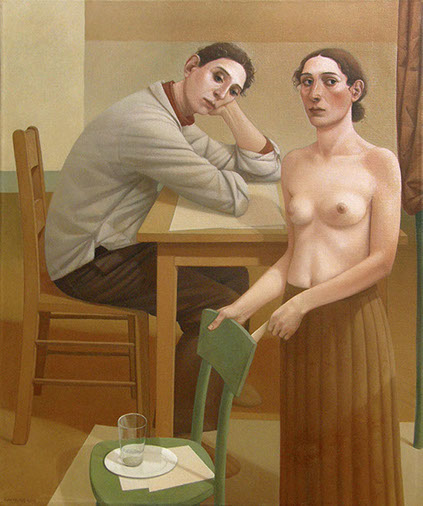
A recurring theme in my own painting is the nude female figure with a clothed male figure, which can imply something private, or personal, and more intimate than a similar imagery with both figures fully clothed. And it can be more interesting than when both figures are nude. A psychological tension can exist better in paintings that include both nude and clothed figures when the imagery doesn’t explain the situation.
However, we can paint the nude figure in various ways. Because of the way I have always been with regard to beautiful women, I find it perplexing that some men paint the female nude devoid of any sensual or sexual qualities at all. For example, in the paintings by Euan Uglow I don’t see any feelings about the beautiful female models who posed for him. I do like Uglow’s paintings for their studied correctness of anatomical structure, and for their color and their composition. Uglow is one of a few painters whose process of pinning down the precise locations of everything they observed shows on the surface of their paintings in the form of little tick marks.
Related Article > How I Create Narrative Paintings With Athletes and Dancers as Models
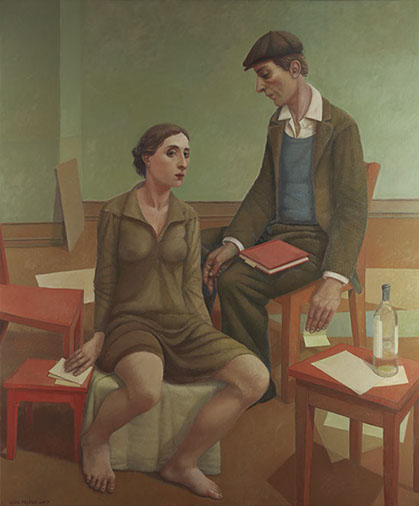
We see this in all the paintings by Euan Uglow and others of his group of English painters, and in some of the Spanish artist Antonio López García’s paintings. An extreme example of this process can be seen in a short film about López García painting a quince tree in his garden. In this kind of painting, the plotting of exact positions can almost read as having been the purpose of the painting, being equal in importance to the subject of the image. We see the painter’s obsession about measuring almost more than we see a quince tree, or a nude woman, in the case of Uglow.
In a similar way I think about the coldness of Rackstraw Downes’ paintings of uninhabited highway underpasses and bridges. It isn’t inherent in a subject matter that it has to seem dry and cold and desolate and without feeling. Wayne Thiebaud’s paintings of urban streets and buildings are exciting and passionate by comparison. To me an Edward Hopper painting of a house sitting alone in a landscape is warmer in feeling than a Rackstraw Downes cityscape.
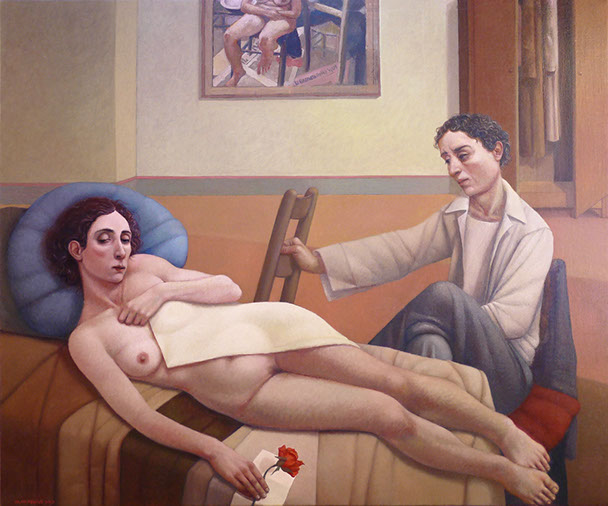
In a long tradition of painting and sculpture dating back to prehistoric and ancient times, the female nude has been admired and appreciated, idealized and idolized. She has been Earth Mother, a personification of nature and motherhood, fertility and creation. And she has also been human and sensual and serene, and innocent and feminine. When she is not symbolic of anything, she is simply an unclothed female figure, completely her unadorned self.
For me, and for many painters, that is how we paint her. Also I think we can see that often there tends to be a difference, whether conscious or unconscious, between how a man and how a woman might paint nude female figures. A man might have a voyeuristic, and maybe a dominating approach to how he portrays the vulnerable aspect of a female nude, while a woman might paint a female nude as an unabashed portrait of her subject. When I look at a female nude painted by Suzanne Valadon, I see a gentle caring image of a woman who is feminine in a painting that is not about sexuality at all.
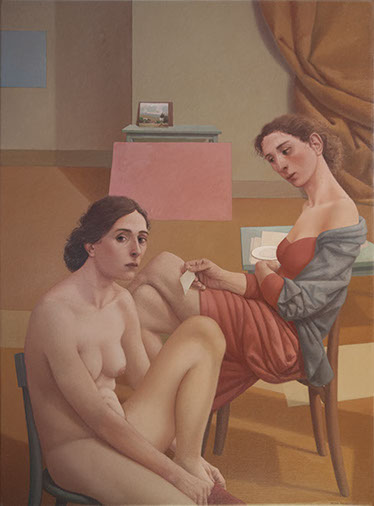
Balthus has been the subject of very heated discussions among painters and art historians because some people vehemently object to his portrayal of girls. They see Balthus as an older man painting lascivious images of young girls in provocative poses. To me, other than the Balthus painting titled “The Guitar Lesson,” painted in 1934 when Balthus was a young man wanting to paint a shocking image in order to draw more attention to himself, Balthus’ paintings show a fair measure of desire, but at the same time they seem respectful of the girls. I might read in them something more akin to feelings about love than about the lechery Balthus has been criticized for. And maybe I think that way because that’s how I regard beautiful female subjects in paintings, whether nude or not.
This article was originally published in 2019
What are your thoughts on figure painting? Share them with us in the comments below.


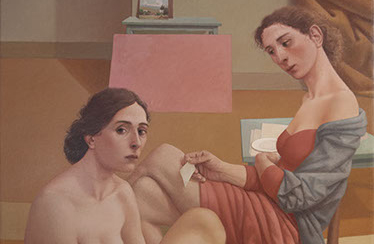



I was curious about your Artikel, but it only tells we always did nude, so do I. To make it a little more interesting, compare how man or women paint male nude. I don’t see many women paint males very sensual, it becomes quickly sexual. If you have sensual paintings from female painters who paint male sensual let me know. Greetings Noel
Rackstraw Downes was my wonderful drawing teacher way back in 1970 in NYC. Thank you for mentioning his very analytical art. He is passionate about it even as he coldly reproduces what is there and perhaps more importantly what is not. There are some video’s online at Youtube on his work for those unfamiliar with his name.
Academic study? Anatomy lesson? Sensual or erotic? Celebrating or exploiting? Who made it weird? Very few galleries will take artwork that depicts nudity unless it’s “tasteful”. What is that, exactly?
One thing’s for sure — depictions of nudity get people riled up;
at least they’re paying attention.
there are many pinup artists famously depicting sensuality in the purpose of anatomy, of course selling to a demand…and many who express painting across the seductive form
That’s been a question on my mind since I got involved with art. Why is it always the woman who is nude? Why not a fully clothed woman and a naked man? For study I understand the need for studying the body etc but for a painting, personally I think it takes away from the narrative trying to come through.
Comments are closed.